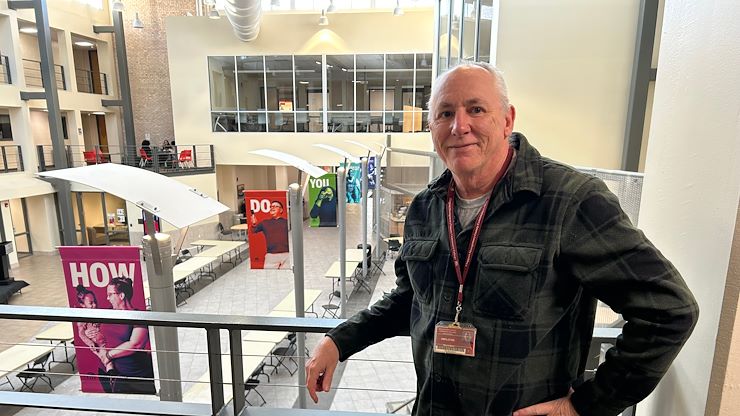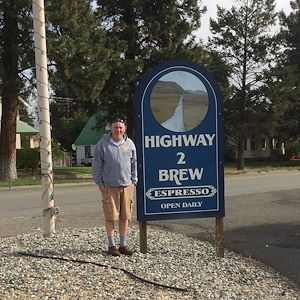
Geography Assistant Professor Wayne Brew traced the 2,500 mile stretch of historic Route 2, as part of a 2017 sabbatical. He was honored by the International Society for Landscape, Place, & Material Culture recently for his longtime service. Photo by Eric Devlin
Montgomery County Community College Geography Assistant Professor Wayne Brew, recent recipient of the W. Frank Ainsley Outstanding Service Award from the International Society for Landscape, Place & Material Culture, is dedicated to bringing geography to life for his students.
He once drove more than 2,500 miles cross country to document the cultural geography of one of America’s oldest interstate highways and to help illustrate the material he teaches every day.
Brew, who’s taught cultural, physical, and world regional geography for the last 25 years at the College, as well as earth science and a food and culture course, said he tries to connect students to real world applications of what they’re studying in his classroom.
“I love teaching people,” he said. “I want to win students over. I tell them, ‘This stuff is interesting if you give it a chance.’”
On the road
During a 2017 sabbatical from the College, Brew, who lives in the Roxborough section of Philadelphia, began a westward journey of U.S. Route 2, documenting the northern-most east-west interstate highway from one end to the other.
First built in 1926, the road is one of the first-generation interstate highways and is separated into sections. The first stretch runs from Houlton, Maine at the Canadian border and ends just east of Rouses Point, N.Y. Then a gap exists in the highway (the interruption) to the Upper Peninsula of Michigan. The road then continues from Sault Sainte Marie, Mich. to Bonners Ferry, Idaho. Lastly, Route 2 was extended in 1946, to Everett, Wash., to cover a total of over 2,571 miles from end to end.
Brew traced the entirety of the roadway, covering what he called “the weird and wonderful commercial architecture, signs, food (pasties), and landscape of Route 2.”
 “The first part took three days. I stopped for a lot for photos,” he said. He also
covered U.S. Route 9, Route 50 and a major stretch of Route 101 on the west coast.
“When these roads were plotted and built, they were the major highways across the
US. In the 1950s and ’60s, these roads were replaced with limited access interstates
built by the federal government under the Defense Highway Act. That relegated these
first-generation interstates to becoming back routes. A lot of what you find along
old routes are old infrastructure. Old motels, gas stations, drive-in theaters, and
diners. I also love to find interesting reuses like a Pizza Hut that’s been turned
into a Moose Club. Or an old KFC that’s now a Chinese restaurant.”
“The first part took three days. I stopped for a lot for photos,” he said. He also
covered U.S. Route 9, Route 50 and a major stretch of Route 101 on the west coast.
“When these roads were plotted and built, they were the major highways across the
US. In the 1950s and ’60s, these roads were replaced with limited access interstates
built by the federal government under the Defense Highway Act. That relegated these
first-generation interstates to becoming back routes. A lot of what you find along
old routes are old infrastructure. Old motels, gas stations, drive-in theaters, and
diners. I also love to find interesting reuses like a Pizza Hut that’s been turned
into a Moose Club. Or an old KFC that’s now a Chinese restaurant.”
Brew returned to Route 2 in the fall of that same year to cover the rest of the road making pitstops at Glacier National Park and taking a side trip to Mount Rushmore and the Badlands in South Dakota along the way.
“South Dakota was the last of the 48 contiguous states for me over my lifetime,” he said. “Zigzagging across the west, I got to visit 15 national parks and monuments. I was on the road for 48 days straight, sometimes sleeping in my car, camping in national forests and parks, and many nights in old, rundown motels.”
The doorway to the world
Brew returned to MCCC to show many of the photos he took during his excursion. His visits to the national parks and monuments come in handy when he’s teaching earth science. He also uses photos to teach about commercial architecture in his cultural geography course.
“There is something special about being able to share the photos and stories behind them with the students,” he said. “They seem to especially like when I tell of my first encounter with a tarantula spider while camping in the mountains in Death Valley.”
Geography remains an important subject for students to learn because it can open the door to the world around them.
“Geography is a synthesizing subject that focuses on physical and cultural spatial patterns,” said Brew. “Human spatial patterns provoke questions, and geography looks to provide answers through the use of demographics, language, religion, history, sociology, politics, economics and anthropology.”
Brew earned bachelor’s degrees in geology and geography from Penn State University. He later earned a master’s in geography from Temple University. In 1984, he began working as a geologist for an environmental consulting firm, and, during a 16-year career with this firm, he travelled widely around the country organizing projects and writing technical reports.
He always had a deep desire to teach, and in 2000 began teaching at MCCC as a full-time instructor, where he earned tenure in 2005, he said. Outside of MCCC, Brew regularly hosts walking historical tours of the Fishtown and Manayunk sections of Philadelphia through Preservation Alliance of Greater Philadelphia.
International praise
Brew’s work has garnered international praise of late, as he was named the recipient of the W. Frank Ainsley Outstanding Service Award by the International Society for Landscape, Place, & Material Culture (ISLPMC). The organization is an “international, interdisciplinary, educational, nonprofit organization that encourages the study and preservation of landscapes and artifacts, and documents sites, structures, and objects representing history and material culture throughout the world,” according to its website.
The Ainsley Outstanding Service Award, established in 2012, is named in memory of long-time member and geographer, Dr. W. Franklin Ainsley, who served as the Society’s Secretary-Treasurer for 20 years. ISLPMC presents this award, only periodically, to a member in recognition of outstanding service and dedication to the Society. The criteria for this award include long-time membership, as well as outstanding service and dedication to the organization through committee work, board membership, executive board membership, and/or planning annual meetings. Brew is a 20-year member of the organization and has been its executive director since 2011.
At the 2024 meeting in Manchester, N.H., he presented a photo essay titled, “Pardon the Interruption, U.S. Route 2,” which documented his 2017 adventure. The organization later surprised him with the award.
“I was thrilled to get the award,” he said. “They managed to find a way to silence me; I was speechless. It’s nice to be recognized.”
